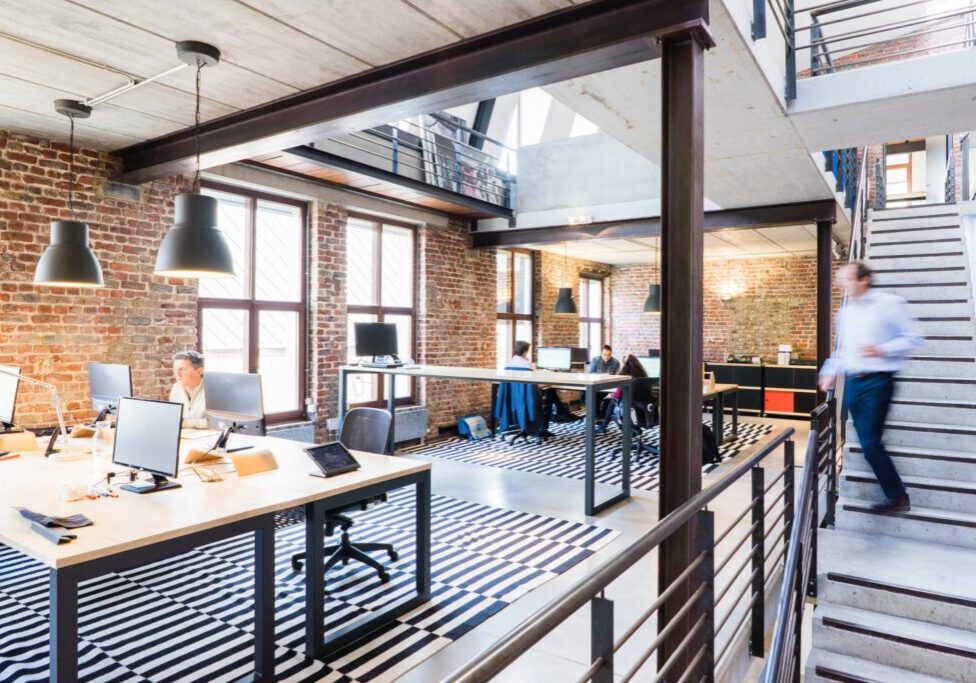According to Axios @ Work, 90% of people surveyed picture an office in their future but don’t picture themselves working there every day. It seems that although most employees are eager to get back to the office in some capacity, the perks of working remotely are not something that they’re ready to trade in for good. What if we found a way to get back in the office safely while still allowing for the flexibility of working from home? Enter the hybrid model.
A survey by PwC estimates that around 50% of office workers will work from home part of each week, and when they’re in the office, there’s no doubt that they’ll be communicating with coworkers who are remote. The offices that we left last year aren’t yet optimized for this format so preparing our physical office spaces for safe, healthy, and productive collaboration is going to take some work, but it’s exciting to have an opportunity to reimagine what’s best for our teams as we move forward.
As you begin to think about how your workspaces will support this new format, here are some tips and resources for rethinking the cube, improving communication between those in the office and at home, and making the office a more social and connected space.
Rethinking the cubical
A high priority before we return to the office is reconfiguring our actual workspaces to ensure that employees feel safe while still having all the tools they need to perform at a high level. Here are a few ideas for getting your space ready:
Harvard Business Review recommends finding a balance between the open plans of the past and the new potential for refreshed social interaction. This may include “incorporating design elements that enable social interactions of many types—from a quick chat at the corner of an open stairway to low-voiced gossip by the kitchen counter or the coffee machine.”
Fast Company reimagines workspaces as “groups of ‘neighborhoods,’ or flexible spaces with movable furniture easily reconfigured by the user where teams can co-locate but seats are not assigned.” The same setup that produces the best acoustics for a Zoom call likely won’t be the same setup that’s best for an in-office meeting so consider investing in modular spaces and furniture.
However your workspaces come together, be flexible and open to rethinking the flow and design of your office as more people begin to collaborate in these spaces and demonstrate their needs in real-time.
Improving the communication experience
For as long as we’ve been scheduling conference calls with our teams, clients, and business partners, there has always been the option of dialing in remotely. And as long as we’ve been dialing in remotely, we’ve been dealing with bad connections and other issues that can arise when technology isn’t perfectly synced to our needs. The return to physical workspaces as part of a hybrid model makes it all the more important to improve the quality of these interactions and create consistency as some employees work in the office and some tune in from home.
While audio and visual technology has improved at an exponential rate recently, the physical office hasn’t always kept up. As you invest in screens, microphones, lighting, and other technology, make sure the layout and acoustics of your meeting rooms are optimized to work with the sound and images that will keep your hybrid team connected.
If you’ve been lax about the use of communication and project management tools in the past, it might also be time to formalize expectations so that no matter where employees choose to spend their workday, everyone in every location has access to the same information, services, and expectations.
The office is still a social hub
As Elizabeth Lowrey points out, “Because the office is no longer a mandate, it must become a magnet—a genuinely welcoming place where employees want to be.” Though the serendipitous breakthroughs that we associate with in-person brainstorming are, by definition, not something that can be manufactured, that doesn’t mean that offices can’t be designed to encourage the conditions in which great ideas are most likely to be produced. A few ways to make the office more social and conducive to collaboration include:
- Creating more break areas where unstructured conversations are likely to happen
- Investing in Bevi and using our touchless technology to stay safe, hydrated, and happy
- Using less sound-absorbent materials in areas where a spontaneous conversation could attract people from different teams that might not otherwise interact
- Organizing hybrid team building activities from Confetti to keep your distributed workforce connected and engaged
Though it’s tempting to discourage socialization as we remain vigilant about health guidelines, research continues to show that the unstructured collaboration that occurs around the watercooler is essential for productivity.
Focus on your employees
As we mentioned in our last post about resources for returning to the office, clear communication with employees is key to a smooth reentry. Input from the people who will actually be inhabiting these redesigned spaces will make sure that they can do their best work. Anecdotal feedback is important, but so is reading between the lines of company data.
For example, one tech company that decided to cut costs and remove their coffee machine was surprised at just how important coffee chats could be. Initially, after the removal of the machine, it looked like productivity increased based on the output of their coders. After looking more closely, however, it turned out that the number of product releases actually went down. The lesson? Informal chats around a coffee machine or smart water dispenser can be just as valuable as meetings on the calendar.
The hybrid model is here to stay, and it has great potential to be a positive change if we properly plan for it. It gives us an opportunity to meld the best of office culture with the flexibility of working from home. We’ve done both independently, and now it’s time to move on to the next generation of working style as we plan our return to the office.
What tips do you have for implementing the hybrid model? We’d love for you to share this article and join the conversation on LinkedIn, Twitter, Instagram, or Facebook!



